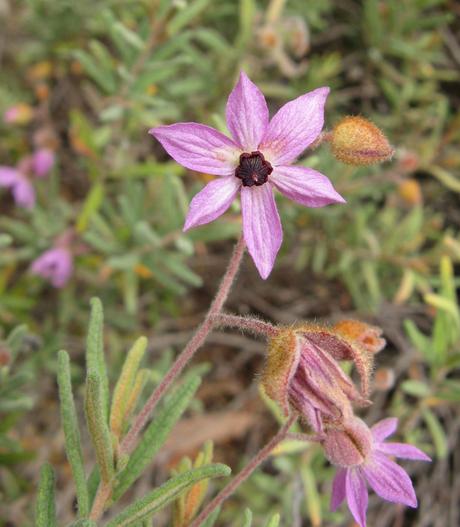Mauve Lysiosepalum
(Lysiosepalum involucratum)
Mauve Lysiosepalum (Lysiosepalum involucratum)
/
/

Nadiatalent
CC BY-SA 3.0
Image By:
Nadiatalent
Recorded By:
Copyright:
CC BY-SA 3.0
Copyright Notice:
Photo by: Nadiatalent | License Type: CC BY-SA 3.0 | License URL: https://creativecommons.org/licenses/by-sa/3.0 | Uploader: Nadiatalent | Publisher: Wikipedia Commons







Estimated Native Range
Summary
Lysiosepalum involucratum, commonly known as the Mauve Lysiosepalum, is a semi-deciduous shrub native to the sandy plains and open eucalyptus forests of Southwestern Australia. It is endemic to the south-west of Western Australia, particularly thriving in well-drained, sandy or loamy soils. This member of the Malvaceae family typically grows to a modest size of 0.3 to 1.5 meters high, with a similar spread. The Mauve Lysiosepalum is notable for its small, rounded form and produces attractive mauve flowers from late winter to mid-spring (August to November in its native range). The flowers are not particularly showy but add a subtle charm to the garden landscape.
The plant is valued for its ability to withstand dry conditions once established, making it suitable for water-wise gardens. It is often used in cultivation for rockeries, native plant gardens, and as a low informal hedge. The Mauve Lysiosepalum prefers a sunny to partially shaded position and thrives in well-drained soil. While it can tolerate low water availability, it benefits from occasional watering during prolonged dry spells. Propagation is most successful from cuttings of semi-mature new growth, as seed germination can be unreliable. Gardeners should be aware that while it is generally disease-free, it may be susceptible to root rot in poorly drained soils.CC BY-SA 4.0
The plant is valued for its ability to withstand dry conditions once established, making it suitable for water-wise gardens. It is often used in cultivation for rockeries, native plant gardens, and as a low informal hedge. The Mauve Lysiosepalum prefers a sunny to partially shaded position and thrives in well-drained soil. While it can tolerate low water availability, it benefits from occasional watering during prolonged dry spells. Propagation is most successful from cuttings of semi-mature new growth, as seed germination can be unreliable. Gardeners should be aware that while it is generally disease-free, it may be susceptible to root rot in poorly drained soils.CC BY-SA 4.0
Plant Description
- Plant Type: Shrub
- Height: 1-1.5 feet
- Width: 1.5-3 feet
- Growth Rate: Moderate
- Flower Color: Pink, Purple
- Flowering Season: Spring
- Leaf Retention: Semi-Deciduous
Growth Requirements
- Sun: Full Sun, Part Shade
- Water: Low
- Drainage: Fast, Medium
Common Uses
Bird Garden, Low Maintenance
Natural Habitat
Sandy plains and open eucalyptus forests in Southwestern Australia
Other Names
Common Names:
Scientific Names: , Lysiosepalum involucratum, Lysiosepalum hexandrum, Lysiosepalum barryanum, Thomasia bexandra, Thomasia hexandra, Thomasia involucrata,
GBIF Accepted Name: Lysiosepalum involucratum (Turcz.) C.A.Gardner